
There are several typical COPD triggers that all patients need to be aware of.
We’ve all been waiting patiently for March! At last, the days are becoming longer and now we can begin to feel the promise of spring in the air. For an individual with COPD, there’s even more cause to celebrate the seasonal changes. Cold, dry air is one of several COPD triggers, and the arrival of warm weather is, literally, a breath of fresh air.
What Are Some Typical COPD Triggers to Avoid?
If a friend or family member struggles with the challenges of COPD, you are all too acquainted with the weariness, difficulty breathing, wheezing and coughing that become part of day-to-day life. Managing these symptoms for the best possible quality of life is a must, and it starts off with learning about the typical COPD triggers to avoid.
Alongside winter weather, below are some additional triggers that may aggravate COPD symptoms and ways in which to find relief.
- Heat and humidity. These can be just as difficult for an individual with COPD to manage as the cold, dry air. A person with COPD should remain inside with air conditioning during the dog days of summer.
- Polluted air. You might automatically think of car exhaust fumes and smog when you think of air pollution, but this includes a number of other irritants as well, such as perfume, paint, mold, pollen, pet dander, cleaning chemicals, or dust. An air purifier can help, and the residence should also be regularly dusted and vacuumed. Someone other than the person with COPD should handle these duties, however, for example a caregiver from Compassionate Nursing Services.
- Viruses. Something as harmless as the common cold could be extremely risky for someone living with COPD. The best techniques to protect against infection include keeping the house sanitized, washing hands regularly, wearing a face mask, and avoiding crowded areas.
- Smoking. Smoking is an activity everyone should stay away from, but for a person with COPD, it’s extremely crucial to quit or never pick up this habit. It’s equally important to avoid secondhand smoke. If the person with COPD struggles to quit smoking, see the doctor for helpful recommendations.
What Are Some Techniques to Ease COPD Symptoms?
While staying away from these triggers is a fantastic starting place to make sure a person with COPD can breathe as comfortably as possible, there are also several breathing exercises that may be helpful, including:
- Pursed lip breathing. This easy exercise can help with relaxation, reducing shortness of breath, and making it easier to breathe. While the mouth is closed, breathe in through the nose to a count of two. Purse the lips, as though blowing out a candle or whistling, and breathe out slowly through the mouth while counting to four. Repeat four to five times daily.
- Deep breathing. Deep breathing helps ease shortness of breath by keeping air from becoming trapped in the lungs. Stand or sit with the elbows slightly back and chest expanded. Breathe in deeply through the nose and hold for a count of five. Breathe out slowly and deeply through the nose until all air is released. Repeat three to four times daily.
- Diaphragmatic breathing. Strengthen the muscles of the abdomen and diaphragm by sitting or lying down and relaxing the shoulders. Place one hand on the abdomen and the other on the chest. Inhale through the nose for two seconds. Focus on moving the stomach more than the chest. Purse the lips and exhale slowly while pressing lightly on the stomach. Repeat as able.
If you’d like more COPD tips or to find out how our trained and experienced in-home care professionals can help make life better for someone you love, call us any time at 314-432-4312.
